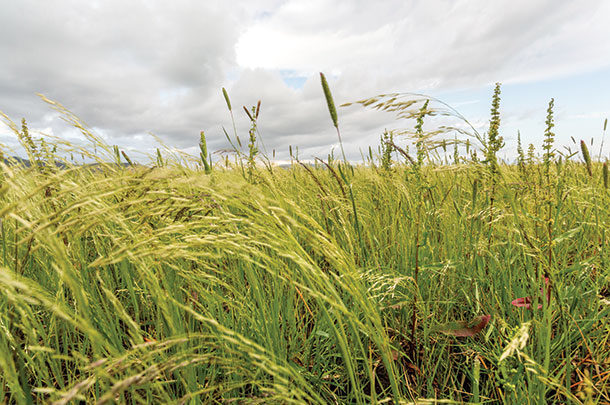But when I moved my family west to Oregon, where I was soon immersed in the forage industry, I began to see opportunities that could offer real competitive advantages. Not necessarily in wheat, barley and peas but in other forage applications, like teff.
With forage, you have options and efficiencies you just don’t see in other segments of the agricultural industry. Teff, in particular, is a unique and versatile crop that can be grown in a multitude of conditions.
This leafy annual grass, native to Ethiopia, produces the world’s smallest identified grain – roughly the size of a poppy seed with a test weight between 60 and 72 pounds per bushel. All varieties can be used in forage, some more desirable than others for milling. My first exposure to teff was in the form of flour, used as an ingredient for Ethiopian food.
Origins
Teff is thought to be one of the world’s earliest domesticated crops. Native to Ethiopia and the broader Horn of Africa region, this ancient grain is thought to date back to a time somewhere between 1,000 B.C. and 4,000 B.C.
In 1895, botanist Joseph Burett-Davy brought teff to the U.S., testing it with some success in California. Since alfalfa was the fodder crop of choice at that time, it struggled to make a name for itself but continued to have limited use in forage. In 1903, he introduced the seed, produced in California, to South African growers, where the crop thrived.
Not only was teff in high demand thereafter, but by 1911, the South African teff seed trade exceeded 50 tons, all of it originating from the half-pound of seed that was produced in California. Quick to mature and efficient to produce, teff could outpace almost all varieties of weeds and became the fodder of choice for South Africans.
Production
In the event other forage crops fail, teff is almost always a viable option. Teff grows in a wide array of soil types, from 2 to 4 feet, and seems to thrive even in marginal ground. Yields are typically 1½ to 2 tons per acre for a given cutting; dry matter yields are typically between 5 and 8 tons per acre.
Because it’s ready to harvest in as little as six weeks from sowing, teff typically produces three crops in a season. If you cut it in the first 55 days, leaving 4 inches of stubble, you can be free of noxious weeds for the next two cuttings.
While the best teff crops are produced in weather between 60ºF and 85ºF, there is little evidence that extreme heat is a detriment to yields. Most forage grasses are a carbon-3 grass; teff is a carbon-4 grass. This is how it avoids the “summer slump” of other forage grasses – it thrives in the kind of heat that would impair most crops.
Drought tolerance
As shifting climate trends present critical shortages, water has become the single-most important factor in determining what we’re going to put in the ground. You see farmers and ranchers alike checking their lists to find which crops require the least amount of water. Sugar beet farmers are moving to oats, pea farmers are moving to barley; everyone is looking for a way to survive while using less water.
The more I learn about teff, the more sense it makes for growing in areas with uncertain water supplies. In fact, one of its most desirable traits – and the catalyst of its resurgence in the U.S. – is its drought tolerance. Historical records show that teff can consistently produce a crop of hay on just 4 inches of water.
Conversely, the grass will thrive in excessive moisture as well. An account from a grower in South Africa reported that with just one heavy rain the day after sowing and with no more rain for 92 days, he produced a serviceable crop. Few crops can withstand that duration of drought and produce any kind of yield. In short, the wide range of moisture required for teff to grow makes it adaptable to the will of Mother Nature.
Cultivation
Teff is best cultivated with an air seeder. A broadcast spinner can be used or a drill, in which case the soil must be firmed before planting. Seed rates are relatively low as compared to most forage crops: The most successful rates are between 5 to 7 pounds per acre with uncoated seed and a marginally higher rate with coated seed, although we’ve even seen successful records of forage crops with 2 pounds-per-acre seeding.
Challenges
Teff is easily grown and susceptible to few diseases, but it does have vulnerabilities, of which freezing temperatures are one. For optimal germination, you want to plant teff in ground temperatures of 65ºF or above, which limits the growing season in some regions. Teff is a grass that thrives in hot and semi-arid conditions and should only be grown in regions that get at least 12 hours of light. (You see significant impact to growth as you head into fall.)
Some teff varieties are susceptible to leaf rust, which can significantly impact yields. And if there is heavy rain just ahead of cutting, the grass will lay down. In addition, the cost of growing teff can be prohibitive, averaging from $1.50 to $3.50 per pound for seed. But when you take the seeding rates into consideration, you can see how the numbers become profitable.
Bottom line
Teff is a highly reliable crop, uniquely suited to a diverse range of growing conditions. Its rapid rate of growth makes it a serious contender for an emergency crop. Maybe not at every elevation where late or early freezes pose an ongoing threat, but broadly speaking, teff has the key attributes to make it a staple forage crop throughout the U.S. If not a solution, it is definitely an avenue worth exploring. FG
PHOTO: Photo provided by Daniel LaFaver via iStock.

-
Daniel LaFaver
- Specialty Grains Manager
- Bridgewell Food & Ag Products











